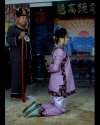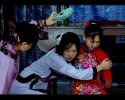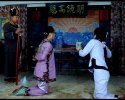-
Sign up or login, and you'll have full access to opportunities of forum.
You are using an out of date browser. It may not display this or other websites correctly.
You should upgrade or use an alternative browser.
You should upgrade or use an alternative browser.
Ancient Chinese Women Prisoners
- Thread starter qasqas
- Start date

Child content... Please read 'Terms and rules' at the bottom of every page...Why was my picture deleted?
willowfall
Senator
The link brings up multiple Malwarebytes warnings of 'riskware' - not certainly malicious, but, like it says, 'risky'.
There are 2 types of computers in the world.
1) Those we know have been hacked.
2) Those we think haven't been hacked.
Welcome to the internet. The most dangerous in a non-violent way place in existence.
Take my word for it as finding stuff on computers you truly hope isn't there is part of my job.
kisses
willowfall
akakak
Spectator
Great pics!!! Where can I watch these films?My favourite actress Qiu E(秋蕚) under heavy torture
View attachment 1476127View attachment 1476128View attachment 1476129View attachment 1476130View attachment 1476131
nsur1
Governor
This one is a beheading execution scene set in ancient China, with all the same trimmings as the usual fetish ones but taken from a mainstream production. Hence, much better production values but alas a last-minute rescue with the scene descending into a standard-issue Asian fight sequence. Nice setup, though, and nice gag.




















svensko
Executioner

[R-18]松平紫姬斩首
感谢孝武帝老师(https://www.pixiv.net/users/9007927)的创作。本次取材自潇湘云雨作者的短篇《樱花殇》,武田悦年幼时旁观族老斩决松平紫姬的片段。作者文笔了得,在看完后忍不住约了一张,如有冒犯请多谅解。 说是请,却和如今一样,女人姣好的身段被绳子捆的结结实实,一双秀气的手捆在背后,被武田家的家老酒井宗苟牵着脖子上的绳子,不过那女人的一头秀发很唐式的盘成了夫人髻,两个堕马鬏垂在双耳,就算被如此对待,步子依旧迈的从容无比,从后头,武田悦能看到她交叉绑在一起的手死死捏着拳头。...
Unfortunately, not everyone can access Pixiv, but if it is original art commissioned by you then 2MB will be fineThis is a picture I paid someone to draw, and I cannot reduce it to below 400kb no matter how, so I am sending it as a link
[R-18]松平紫姬斩首
感谢孝武帝老师(https://www.pixiv.net/users/9007927)的创作。本次取材自潇湘云雨作者的短篇《樱花殇》,武田悦年幼时旁观族老斩决松平紫姬的片段。作者文笔了得,在看完后忍不住约了一张,如有冒犯请多谅解。 说是请,却和如今一样,女人姣好的身段被绳子捆的结结实实,一双秀气的手捆在背后,被武田家的家老酒井宗苟牵着脖子上的绳子,不过那女人的一头秀发很唐式的盘成了夫人髻,两个堕马鬏垂在双耳,就算被如此对待,步子依旧迈的从容无比,从后头,武田悦能看到她交叉绑在一起的手死死捏着拳头。...www.pixiv.net

like your postings, can you post more?View attachment 1260485Let me try.
willowfall
Senator
Having been punched in the stomach (and also having taken a football helmet there when being tackled) I cam imagine how much this hurts.
Especially since the board keeps you in place and enhances the force of the blow.
kisses
willowfall
EZ8
Spectator
for abortion / destroying the uretusSome ancient Chinese punishment that uses a big hammer to hit a woman's belly and damage her uterus
View attachment 1501568
No, not for abortion, normally, but for destroying the uterus, and making a female forever incapable of getting pregnant and give birth. Actually, the procedure depicted at the picture was common until the Han Dynasty, being merely a standard female equivalent of males' punishment by castration. Then such women. if they survived the damage, were supposed to be sent to do hard labour at the military camps and remote construction projects. The procedure was called '宫刑', being one of the 'Five Punishments' of the pre-Imperial and Early Imperial China. For women, the treatment was described in the surviving textual sources (admittedly, of a later period) as 'using a large wooden hammer to damage her uterus'. Ceased to be used (officially, at least) in the 2nd century BC, when emperor Wen-di abolished some 'excessive punishments'.for abortion / destroying the uretus
thats quite correct, i was going to add that to my post, but thanks anywayNo, not for abortion, normally, but for destroying the uterus, and making a female forever incapable of getting pregnant and give birth. Actually, the procedure depicted at the picture was common until the Han Dynasty, being merely a standard female equivalent of males' punishment by castration. Then such women. if they survived the damage, were supposed to be sent to do hard labour at the military camps and remote construction projects. The procedure was called '宫刑', being one of the 'Five Punishments' of the pre-Imperial and Early Imperial China. For women, the treatment was described in the surviving textual sources (admittedly, of a later period) as 'using a large wooden hammer to damage her uterus'. Ceased to be used (officially, at least) in the 2nd century BC, when emperor Wen-di abolished some 'excessive punishments'.
I saw some pictures (a few), but the ladies are depicted being nicely dressed during the procedure. Not merely boring, but also historically inaccurate. We have primary source evidence about condemned Chinese women being frequently partially or fully undressed before any execution, even strangulation, where dress does not create any obstacles for the executioners. Thus this censorship-inspired propriety does not look plausible.also, I am looking forward to someone recreating this idea, the picture I posted there is quite an old one (as far as I remember I saw it once like 8 years ago) and I haven't seen anyone draw anything like that
Naraku
Draconarius
I find it difficult to believe any woman could survive this procedure.No, not for abortion, normally, but for destroying the uterus, and making a female forever incapable of getting pregnant and give birth. Actually, the procedure depicted at the picture was common until the Han Dynasty, being merely a standard female equivalent of males' punishment by castration. Then such women. if they survived the damage, were supposed to be sent to do hard labour at the military camps and remote construction projects. The procedure was called '宫刑', being one of the 'Five Punishments' of the pre-Imperial and Early Imperial China. For women, the treatment was described in the surviving textual sources (admittedly, of a later period) as 'using a large wooden hammer to damage her uterus'. Ceased to be used (officially, at least) in the 2nd century BC, when emperor Wen-di abolished some 'excessive punishments'.
Some seemingly did. The torture specialists probably knew how to ruin the reproductive system without killing the criminal - or, at least, with keeping chances of her dying at, say, some 50%. Perhaps, a few well-directed strikes would do the job. It was not necessary to crush into a mash everything inside the condemned woman's low belly. They had a lot of time and a lot of criminals to find out the right ways. But these secrets are long lost...I find it difficult to believe any woman could survive this procedure.
Naraku
Draconarius
I just don't think a blow hard enough to rupture the uterus could avoid also rupturing the surrounding organs; namely, the colon and bladder; either of which would; in a time before modern medicine; result in death from sepsis and/or internal hemorrhage. Even crushing the uterus alone could result in fatal hemorrhaging.Some seemingly did. The torture specialists probably knew how to ruin the reproductive system without killing the criminal - or, at least, with keeping chances of her dying at, say, some 50%. Perhaps, a few well-directed strikes would do the job. It was not necessary to crush into a mash everything inside the condemned woman's low belly. They had a lot of time and a lot of criminals to find out the right ways. But these secrets are long lost...
I am skeptical of something refereed to only in later sources.










